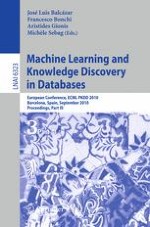2010 | Book
Machine Learning and Knowledge Discovery in Databases
European Conference, ECML PKDD 2010, Barcelona, Spain, September 20-24, 2010, Proceedings, Part III
Editors: José Luis Balcázar, Francesco Bonchi, Aristides Gionis, Michèle Sebag
Publisher: Springer Berlin Heidelberg
Book Series : Lecture Notes in Computer Science
